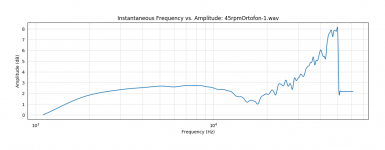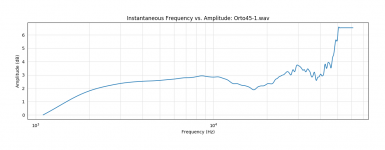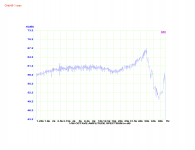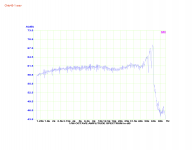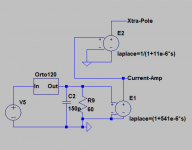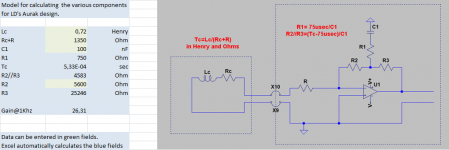Your two below. The one looks pretty much the same as mine. L and R file: Dropbox - Orto45_P100.wav - Simplify your life
Attachments
Standardisation on 47k with noisy jfet or even cmos opamps was incompatible
How so?. Stylus up the noise spectrum is dead perfect RIAA shaped white noise w/47K||250pF. JFET op-amps of the day were 8-14nV and were not particularly suitable for any MM input.
And via MI:
Any reason the >50K disappeared above, 192K should work to 96K? I don't have any 192K cards here to try.
EDIT - Looks OK here from your file out to 67.5K as it should.
No sorry, 192K cuts off like it was 96K I'll look into it.
Last edited:
I don't know - haven't looked in to it. Noticed it on my files that were >50K yesterday too. The one I posted today has that content, as does what Hans posted if you want to play with it.
No I'm on it, I did say I was unsure about the smoothing being robust. Well you made a file that gives me the chance to fix it. Everything is still correct but the data smoothing stops when the are big jumps in frequency in the 10ms window (at the high end). This will be easy to fix, I still think having the hi-res smoothed data has use.
I have a 2i2 serial number dated 11/2014 and it only lights up 96k sampling on WIN10. Thanks for the offer, I'll bother you if it could be of real use.
JP,Your two below. The one looks pretty much the same as mine. L and R file: Dropbox - Orto45_P100.wav - Simplify your life
First conclusion is that your L and R channel are perfectly the same, really great. It's therefore a safe assumption that both channels on the record are also exactly the same.
I probably have to do some adjustment, but anyhow especially above 30kHz the channels of my Cart differ at some points as much as 3dB.
No problem for Audio, but a problem when validating records up to 50kHz.
However what is very hard to answer is, what should the FR look like ?
I find it a bit hard to believe that highly skilled people like Ortofon are bringing a record on the market with such a deviation from the straight line.
On top of that, it's quite curious that from slightly below 20kHz, deviation is almost a perfect straight line going upwards with 20dB/dec, a coincidence or programmed that way ??
Because I'm still used to my way of imaging, I have attached both channels for your and for mine element, they corresponds with your MI images (what it is that MI stands for ?) and the Python images.
That's why I used my images, because I still have them all together by name.
So where does this leave us to your opinion ?
Do some further investigation of the Ortofon record with a different Cart ?
And even if the Ortofon is not straight, when we could validate the FR curve.
In that case we have a validated record that is still available for sale, which might be a large benefit.
From my side I will try to get in contact with Ortofon to ask them what exactly is recorded.
Hans
Attachments
Hans,
Not sure if I missed it in the flurry but did you list the load resistor you used in your transamp simulations for the MMs for the superOM and AT150? As priority want to get my aurak setup for measuring those.
As an aside, looking at how the S-120 changes with frequency (and not totally suprised as its a hoofing great 900mH generator) I am tempted to run some numbers to see how Cordell style damped loading might work.
All very interesting
Not sure if I missed it in the flurry but did you list the load resistor you used in your transamp simulations for the MMs for the superOM and AT150? As priority want to get my aurak setup for measuring those.
As an aside, looking at how the S-120 changes with frequency (and not totally suprised as its a hoofing great 900mH generator) I am tempted to run some numbers to see how Cordell style damped loading might work.
All very interesting
Bill,Hans,
Not sure if I missed it in the flurry but did you list the load resistor you used in your transamp simulations for the MMs for the superOM and AT150? As priority want to get my aurak setup for measuring those.
As an aside, looking at how the S-120 changes with frequency (and not totally suprised as its a hoofing great 900mH generator) I am tempted to run some numbers to see how Cordell style damped loading might work.
All very interesting
I used the same 60 Ohm resistor for all Carts.
Calculating Tc=Lc/(Rc+60) gave me the exact time constant to enter in the Laplace filter in the image below.
When you want to configure your Aurak for any combination, look below:
Hans
Sorry, gave the wrong link, this one is correct.
Cartridge dynamic behaviour
Attachments
Last edited:
Ah OK, so just have to extract the Resistance from your model.
I’m not sure if I got what you meant.
If you like to use a simple formula like (R+Rc)=2Lc then Tc should be 500usec.
When going for (R+Rc)=3Lc, then Tc has to be 333usec.
But by using the Excel calculator, you can use anything you like and all components will be calculated for you.
When in doubt, I’ll be happy to assist you.
Hans
JP,
Could you be so kind to send me your Ortofon 33 1/3rpm .wav recording.
This will be helpful in my communication with Ortofon as to explain why we tried 45rpm,
I can, but it'd be this upcoming weekend as we spend weekend and weekdays in separate locations; different computers.
O.k. let's say you have the basic Aurak version, as originally shown by LD with 180nF+420Ohm and 4K2+5k4My point is that I don't know R at the moment. L I can read off the graphs. It was just if there was a record of it before I did the sums.
When using a S-120 with 720mH and 1250Ohm, you should say 2*720-1250=190Ohm. That will then be your series resistor R.
When are still free to select all the components and you want R=100Ohm instead of 190Ohm, and 100nF instead of 180nF, the calculator gives you the answer below.
Hans
Attachments
I can, but it'd be this upcoming weekend as we spend weekend and weekdays in separate locations; different computers.
O.k. no problem, I’ll wait to contact Ortofon till after the coming weekend.
Hans
Thank you JP, just crunching it.
Do you know what CV velocity the sweep is recorded at, or can you deduce it from the reference 1kHz tone on the Ortofon record?
If you do run a 33rpm sweep, would you kindly post a dropbox link?
thx again LD
@JP I fixed the 45 rpm sweep at high frequencies, I over thought the problem the plot routine already interpolates over missing frequency bins. At 45rpm there are a lot of missing frequencies even at 10ms sample windows because the exponential sweep is going so fast at the end. I'll send you something for next weekend. Everything agrees again.
- Home
- Source & Line
- Analogue Source
- Cartridge dynamic behaviour
